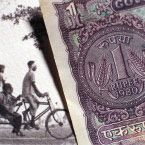Report From: India
Differential pricing is making more than just an appearance in Asia's pharma market these days.
Differential pricing is making more than just an appearance in Asia's pharma markets these days.
It has been known to happen. Merck & Co. did it with "Stromectol" (ivermectin). Pfizer did it with "Diflucan" (fluconazole). Glaxo-
SmithKline (GSK) did it with its vaccines. Each of these drugmakers has adopted differential pricing in the pharmaceutical market. That is, they offer lower drug prices to developing countries but maintain normal prices elsewhere.

(IMAGE: CHRISTIAN ZACHARIASEN/GETTY IMAGES)
Initially the backbone of the pharmaceutical delivery system in the United States, differential pricing has now made an appearance in India, where the industry is ripe for change. Global pharmaceutical companies are launching medicines in India at prices as low as one-fifth of their developed-country prices. Daiichi Sankyo (Tokyo), Merck & Co (Whitehouse Station, NJ), Pfizer (New York), and GSK (London) are all adopting India-specific pricing. Several others are keen to follow.
This so-called "peace offering" comes not because the Indian government is wielding the big stick of busting patents. Rather, the country's expanding middle class provides too tantalizing a carrot to be ignored. Consulting firm McKinsey & Company estimates that the value of the Indian pharmaceutical market will grow from $6.3 billion in 2005 to $20 billion in 2015. As growth slows in developed markets and drug companies battle the twin threats of generic drugs and price controls, differential pricing is proving to be a beacon of hope in the long, dark tunnel.
The second largest Japanese pharmaceutical company, Daiichi Sankyo, is set to launch its hypertension drug, olmesartan medoxomil, in India at about one-fifth of its European price. Pfizer launched its patented antismoking medicine "Champix" (varenicline tartrate) at a considerable discount in India as well. People who want to quit smoking in India will pay Rs 9500 ($225) for a 12-week regimen, while their US counterparts have to shell out more than twice the amount, about $522.
Similarly, New Delhi Gurgaon-based MSD Pharmaceuticals, the Indian subsidiary of Merck & Co., recently launched its once-a-day patented diabetes drug "Januvia" (sitagliptin) at Rs 43 ($1) per tablet, or about Rs 1,290 ($30) per month, which is one-fifth of its US price of $150 per month. Not to be outdone, GSK priced its recently launched anticancer drug "Tykerb" (lapatinib) in India at a 25% discount from global prices.
What exactly is happening here? Although several global pharmaceutical companies have used differential pricing as a sales strategy in the past, offers to slash prices of anti-AIDS medicines for African countries or provide cheaper condoms and contraceptives to aid family planning in developing countries do not seem to fall into the same category.
Many companies differentiate prices according to socioeconomic indicators to make drugs equally affordable to people with various incomes and to countries with varying disease rates. Ideally, this approach yields prices that are affordable to both low- and middle-income nations and maintains incentives for research and development. For global companies, the pricing policy serves public health by ensuring the greatest affordability of patented drugs while maximizing profits.
"Daiichi Sankyo wants to sell olmesartan medoxomil in India at Rs 9 ($0.21) for a 200-mg tablet. The drug costs between $1 and $1.2 in Europe (Rs 42–50)," says a senior official from New Delhi-based Ranbaxy Laboratories. "The discounted drug is bound to reach a larger section of society here, which will pay for the [company's costs] in the long run," he explains. Incidentally, Daiichi Sankyo recently acquired Ranbaxy for $3.7 billion; the buyout has not affected the company's dual-pricing policy.
Unsurprisingly, the change in pricing has everyone's attention. "Merck's is probably the first case of differential pricing implemented by Big Pharma in India," says Utkarsh Palnitkar, national sector leader for health sciences at Ernst & Young, in Hyderabad. "Other drug companies are adopting a wait-and-watch approach."
For many, differential pricing is being touted as part corporate social responsibility and part hard-nosed economics. "Merck's tagline is 'Patients Come First,'" says Merck MSD's Naveen Rao. It is also a business strategy, however, as Merck aims to be among the top five drug companies in India by 2015. It is currently ranked 120, according to the market research firm ORG IMS.
Although Merck is a well-chronicled example, GSK's Corporate Communication Officer Sunder Rajan says that differential pricing has applied to several products. "The function of price depends on how much the market can absorb. Pricing is technical and is based on local conditions," he adds.
In a country such as India, dual pricing imposes a dual challenge. "We have two Indias within India," says Ranjit Shahani, CEO of Novartis India. "On one end, there are people who can afford world-class medication and prices, and on the other hand, there are many who can't afford one square meal a day. Drug firms have to recognize this basic difference. The challenge remains how they will continue to do business in India which, today, is a branded generic market," adds Shahani.
Different pricing approaches can also prevent sensible collaboration. For example, Mumbai-based Cipla offered to sell its 3-in-1 anti-AIDS drug, "Viraday," which contains the active ingredients tenofovir disoproxil fumarate, emtricitabine, and efavirenz, at Rs 21,000 ($500) per year to Doctors without Borders. In India, the drug is priced at Rs 54,000 ($1285), thus restricting access to many AIDS patients. Cipla does, however, conduct a quarterly review of its prices for AIDS drugs and is expected to lower prices this month.
There are other inherent flaws of dual pricing. Companies are aware of the danger that cheap drugs intended for the poorest individuals will be pilfered and sold at a profit to the urban middle classes or shipped overseas to rich countries. Not only can these illegal practices defeat the entire purpose of differential pricing but companies affirm they can damage profitability, introduce a risk of mislabeling (when goods are repackaged), and serve as an entry point for counterfeit drugs.
India's developed and developing pockets pose a challenge as well. How does one divide markets within the same country and more importantly, how does one prevent price arbitrage within these markets? The question is a quagmire alright, but one which Big Pharma is clearly not willing to address for now, in its eagerness to get a larger slice of the market.
A. Nair is a freelance writer based in Mumbai, India.
